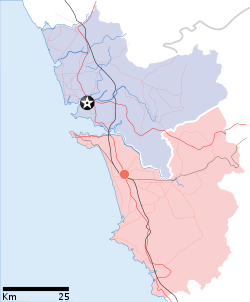- Mormugao
-
Mormugao — city — Coordinates 15°24′N 73°48′E / 15.40°N 73.80°ECoordinates: 15°24′N 73°48′E / 15.40°N 73.80°E Country India State Goa District(s) South Goa Population 97,085 (2001[update]) Time zone IST (UTC+05:30) Area
• 2 metres (6.6 ft)
Mormugao or Marmagao (formerly Mormugão in Portuguese) is a city and a municipal council in South Goa district in the Indian state of Goa. It is Goa’s main port. It was featured in the 1980 film The Sea Wolves and the Bollywood film Bhootnath.
Contents
Geography
Mormugao is located at 15°15′N 73°59′E / 15.25°N 73.98°E.[1] It has an average elevation of 2 metres (7 feet).
Demographics
As of 2001[update] India census,[2] Mormugao had a population of 97,085. Males constitute 53% of the population and females 47%. Mormugao has an average literacy rate of 75%, higher than the national average of 59.5%: male literacy is 80%, and female literacy is 70%. In Mormugao, 11% of the population is under 6 years of age.
History
When the Portuguese colonised part of Goa in the sixteenth century, they based their operations in the central district of Tiswadi, notably in the international emporium 'City of Goa', now Old Goa. As threats to their maritime supremacy increased, they built forts on various hillocks, especially along the coast. In 1624, they began to build their fortified town on the headland overlooking Mormugao harbour.
The sultans of Bijapur, who had colonised Goa before the Portuguese, did not give up easily. There were several invasions. From the sea came the Dutch, who eventually took over from the Portuguese most of the coastal settlements: the Moluccas, Batticaloa, Trincomali, Galle, Malacca, Manar, Jaffna, Quilon, Cochin and Cannanore. From 1640 to 1643, the Dutch tried their best to capture Mormugao but were finally driven away.
In 1683, the Portuguese in Goa were in grave danger from the Marathas. Almost certain defeat was averted when Sambhaji suddenly lifted siege and rushed to defend his own kingdom from the Mughal Emperor Aurangzeb. The narrow escape, no less than the decline of the City of Goa, convinced the Portuguese viceroy, Dom Francisco de Távora, that he should shift the capital of the Portuguese holdings in India to Mormugao’s formidable fortress.
In 1685, the new city’s principal edifices were under construction, with the Jesuit priest Father Teotónio Rebelo in charge. The Jesuit architects made a consistent effort to avoid the ornate style of the time. The austere viceregal palace still stands, having been used, after its short stint as a palace, in various capacities, including as the hotel which housed the British agents who in 1943 destroyed German ships anchored in Mormugao’s neutral waters. Viceroys after Távora found Mormugao too secluded for their liking. The administrative headquarters were moved to the new city of Panjim, which is till today Goa’s chief city.
Mormugao Port
Ever since it was accorded the status of a Major Port in 1963, the Mormugao port has contributed immensely to growth of maritime trade in India. It is the leading iron ore exporting port of India with an annual throughput of around 27.33 million tonnes of iron ore traffic.[3]
Transport links
Epidemics devastated Mormugao during the eighteenth century, but after that its fortunes turned. As the importance of one of India’s best natural harbours grew more apparent, Mormugao, which the British called Marmagoa, became a key trading point. It was chosen for the terminus of the new metre gauge [4] railway linking the Portuguese colony to British India. For a fabulous price, the Western India Portuguese Guaranteed Railways Company, a British enterprise, modernised the port and built the railway. Both were opened to the public in July 1886.
Mormugao’s city of Vasco da Gama was planned and built in the early years of the twentieth century. A colourful city of officials, traders and migrant labourers, it had its Portuguese academies and British club life for several decades. Now rather scarred, Mormugao district continues to be unique in Goa.
With Goa’s airport at Dabolim, the railway terminus at Vasco da Gama, and the busy port, Mormugao is many visitors’ first experience of Goa.
Politics
The area is part of the Mormugao Lok Sabha constituency (also known as South Goa). The Congress candidate Francisco Sardinha won the 2007 Lok Sabha bypoll elections, defeating his close rival Dr. Wilfred Mesquita of the Bharatiya Janata Party by a margin of over 40,000 votes.
Mormugao also elects an MLA to the Goa State Assembly. The current MLA is Milind Naik of the Bharatiya Janata Party.
See also
- Ports in India
- Kolkata Port
References
- ^ Falling Rain Genomics, Inc - Mormugao
- ^ "Census of India 2001: Data from the 2001 Census, including cities, villages and towns (Provisional)". Census Commission of India. Archived from the original on 2004-06-16. http://web.archive.org/web/20040616075334/http://www.censusindia.net/results/town.php?stad=A&state5=999. Retrieved 2008-11-01.
- ^ http://www.mptgoa.com/
- ^ http://www.webcitation.org/query?url=http://www.geocities.com/wp7713/vasco_vindaloo.htm&date=2009-10-26+00:18:43
External links
- The Goa Jesuit Province of the Society of Jesus - The Jesuits in Goa
Categories:- Cities and towns in South Goa district
- Port cities in India
Wikimedia Foundation. 2010.




